Griffith University Report: Understanding Risky Play in Queensland
VerifiedAdded on 2022/08/21
|39
|10603
|21
Report
AI Summary
This report provides an in-depth analysis of risky play in Queensland, Australia, focusing on its significance for child development and health outcomes. It begins by defining risky play and its benefits, including the development of physical, social, and cognitive skills. The report then explores facilitative strategies for promoting risky play in young children, emphasizing the importance of a supportive environment that encourages exploration and challenges while mitigating risks. Furthermore, it examines various programs and interventions implemented in Queensland, Australia, that support risky play, such as Nature Play, and discusses their aims and outcomes. The methodology section details the use of secondary data, including existing literature and published articles, to gather information on how risky play is conceptualized and supported in Western society. The report concludes by highlighting the importance of promoting risky play to foster children's overall well-being and provides valuable insights for parents, educators, and policymakers seeking to enhance children's opportunities for play and development. The report also includes a discussion on the decline in children's outdoor play due to safety concerns and overprotective parenting practices, offering a comprehensive overview of the topic.
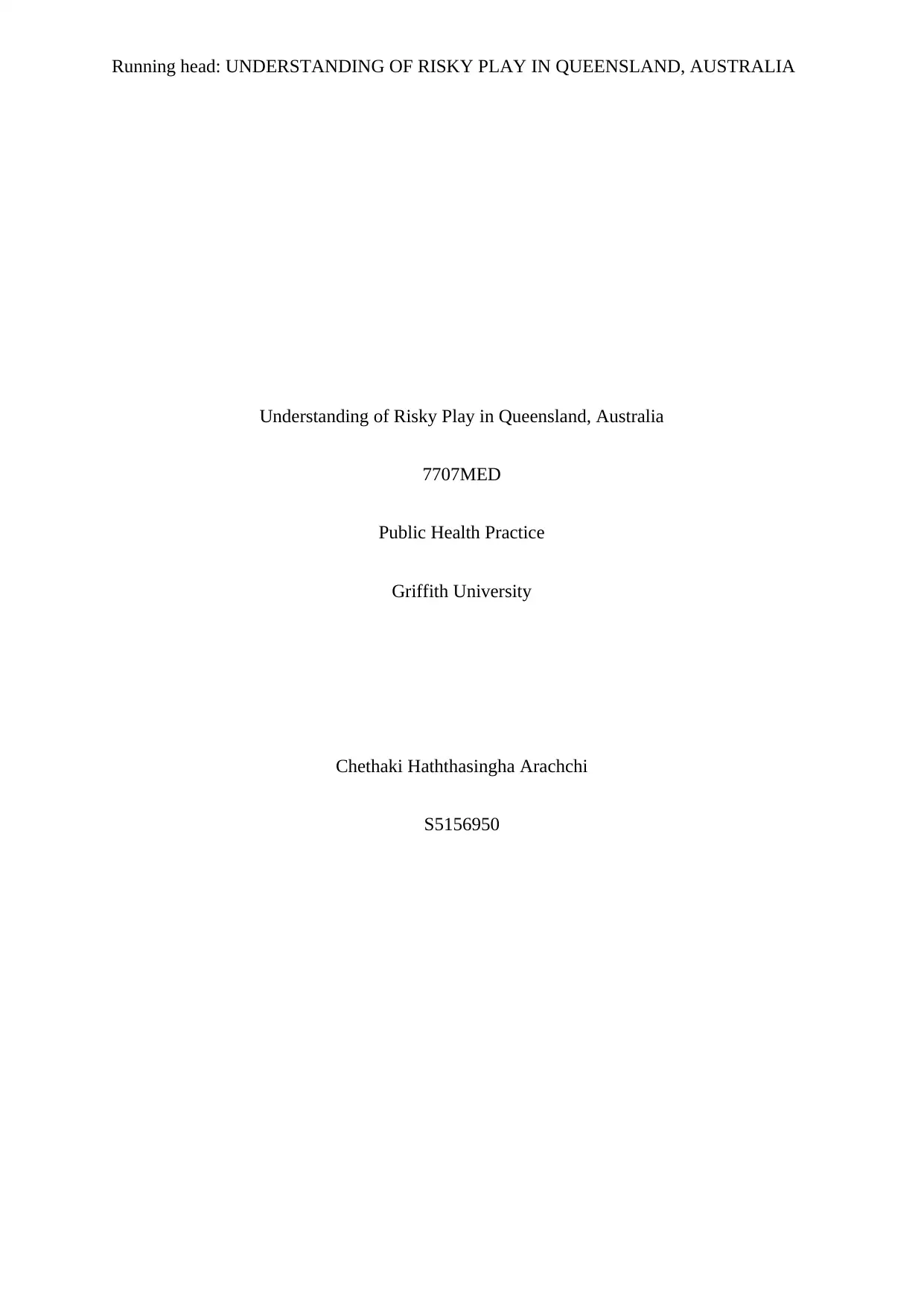
Running head: UNDERSTANDING OF RISKY PLAY IN QUEENSLAND, AUSTRALIA
Understanding of Risky Play in Queensland, Australia
7707MED
Public Health Practice
Griffith University
Chethaki Haththasingha Arachchi
S5156950
Understanding of Risky Play in Queensland, Australia
7707MED
Public Health Practice
Griffith University
Chethaki Haththasingha Arachchi
S5156950
Paraphrase This Document
Need a fresh take? Get an instant paraphrase of this document with our AI Paraphraser
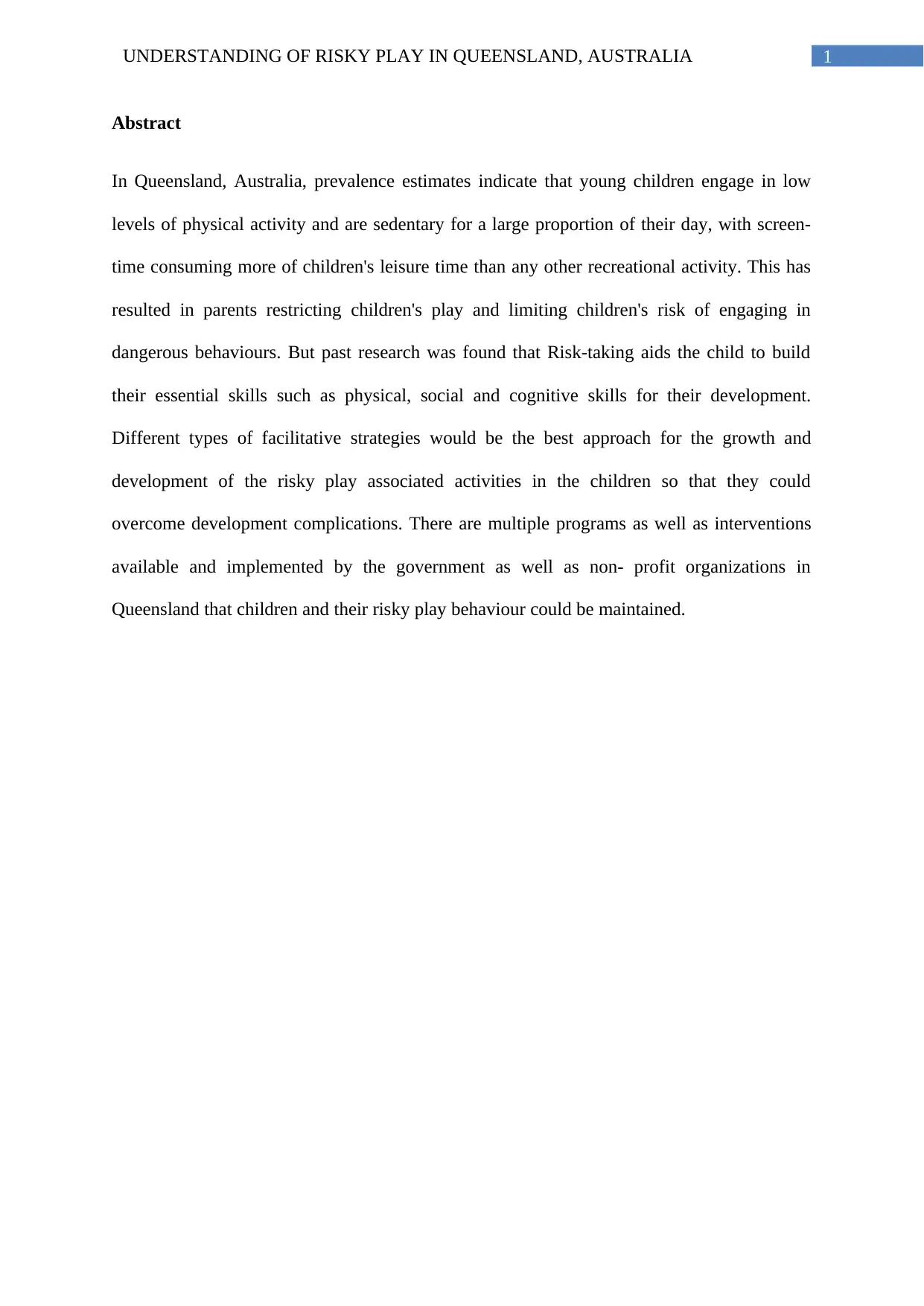
1UNDERSTANDING OF RISKY PLAY IN QUEENSLAND, AUSTRALIA
Abstract
In Queensland, Australia, prevalence estimates indicate that young children engage in low
levels of physical activity and are sedentary for a large proportion of their day, with screen-
time consuming more of children's leisure time than any other recreational activity. This has
resulted in parents restricting children's play and limiting children's risk of engaging in
dangerous behaviours. But past research was found that Risk-taking aids the child to build
their essential skills such as physical, social and cognitive skills for their development.
Different types of facilitative strategies would be the best approach for the growth and
development of the risky play associated activities in the children so that they could
overcome development complications. There are multiple programs as well as interventions
available and implemented by the government as well as non- profit organizations in
Queensland that children and their risky play behaviour could be maintained.
Abstract
In Queensland, Australia, prevalence estimates indicate that young children engage in low
levels of physical activity and are sedentary for a large proportion of their day, with screen-
time consuming more of children's leisure time than any other recreational activity. This has
resulted in parents restricting children's play and limiting children's risk of engaging in
dangerous behaviours. But past research was found that Risk-taking aids the child to build
their essential skills such as physical, social and cognitive skills for their development.
Different types of facilitative strategies would be the best approach for the growth and
development of the risky play associated activities in the children so that they could
overcome development complications. There are multiple programs as well as interventions
available and implemented by the government as well as non- profit organizations in
Queensland that children and their risky play behaviour could be maintained.
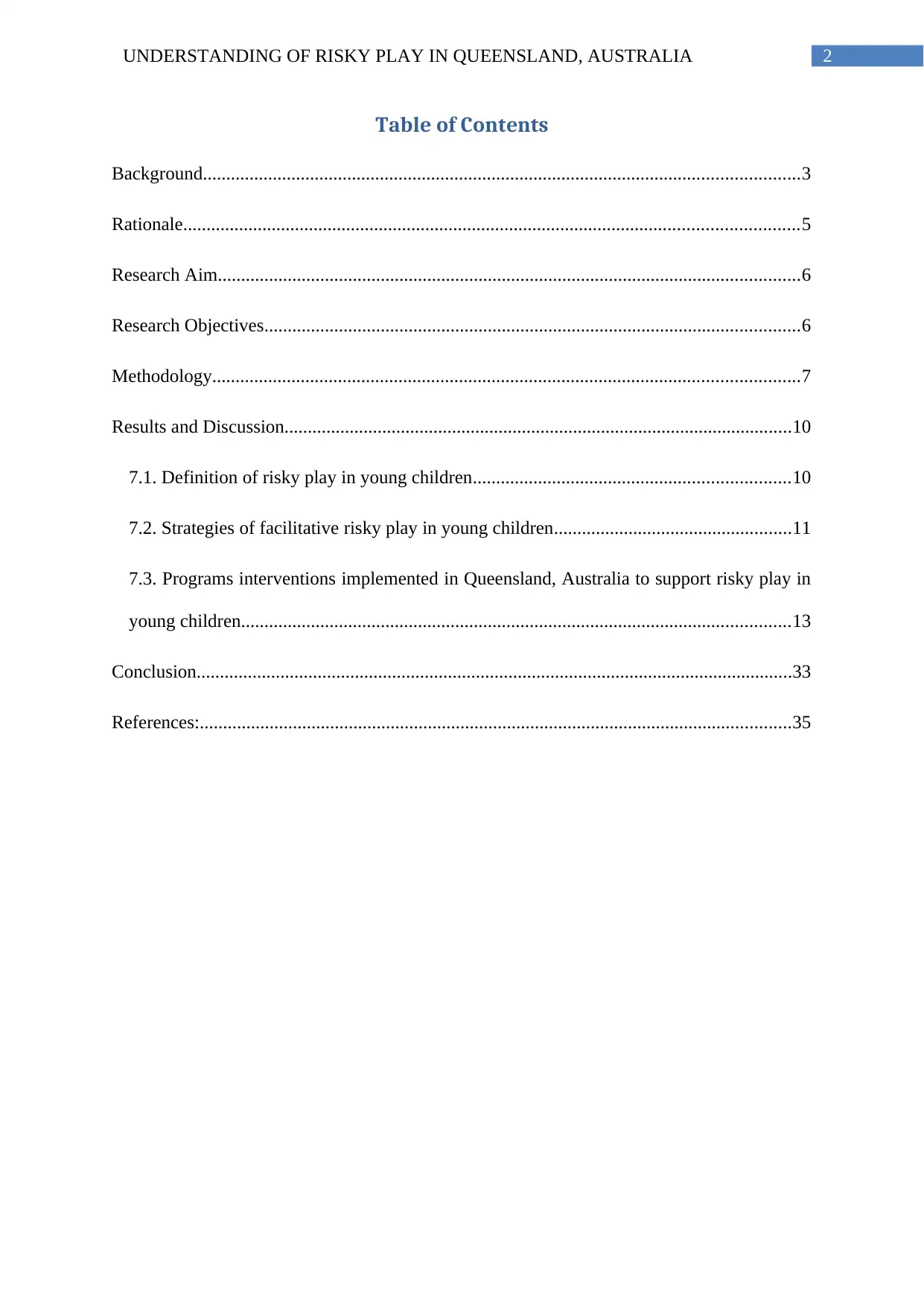
2UNDERSTANDING OF RISKY PLAY IN QUEENSLAND, AUSTRALIA
Table of Contents
Background................................................................................................................................3
Rationale....................................................................................................................................5
Research Aim.............................................................................................................................6
Research Objectives...................................................................................................................6
Methodology..............................................................................................................................7
Results and Discussion.............................................................................................................10
7.1. Definition of risky play in young children....................................................................10
7.2. Strategies of facilitative risky play in young children...................................................11
7.3. Programs interventions implemented in Queensland, Australia to support risky play in
young children......................................................................................................................13
Conclusion................................................................................................................................33
References:...............................................................................................................................35
Table of Contents
Background................................................................................................................................3
Rationale....................................................................................................................................5
Research Aim.............................................................................................................................6
Research Objectives...................................................................................................................6
Methodology..............................................................................................................................7
Results and Discussion.............................................................................................................10
7.1. Definition of risky play in young children....................................................................10
7.2. Strategies of facilitative risky play in young children...................................................11
7.3. Programs interventions implemented in Queensland, Australia to support risky play in
young children......................................................................................................................13
Conclusion................................................................................................................................33
References:...............................................................................................................................35
⊘ This is a preview!⊘
Do you want full access?
Subscribe today to unlock all pages.

Trusted by 1+ million students worldwide
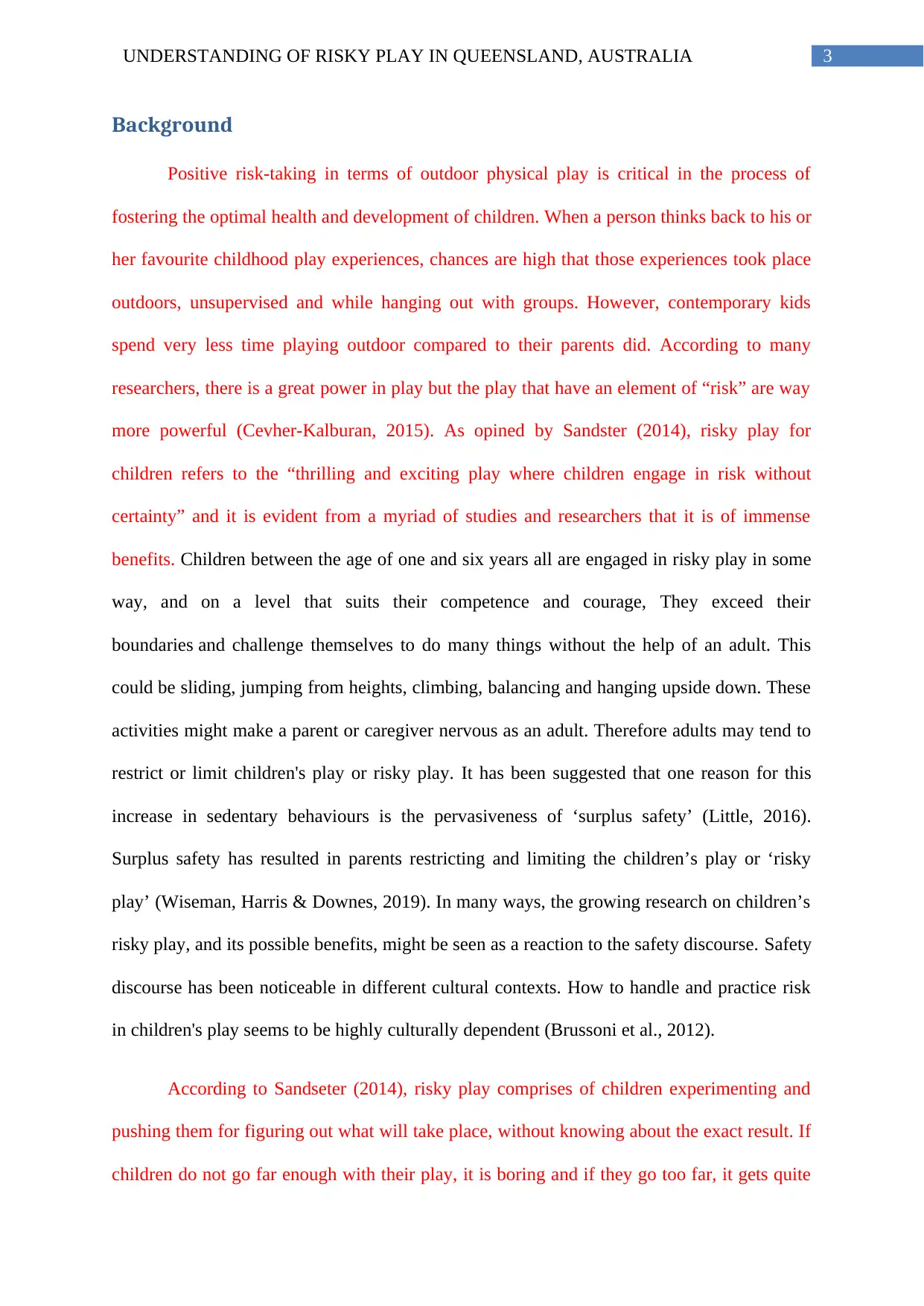
3UNDERSTANDING OF RISKY PLAY IN QUEENSLAND, AUSTRALIA
Background
Positive risk-taking in terms of outdoor physical play is critical in the process of
fostering the optimal health and development of children. When a person thinks back to his or
her favourite childhood play experiences, chances are high that those experiences took place
outdoors, unsupervised and while hanging out with groups. However, contemporary kids
spend very less time playing outdoor compared to their parents did. According to many
researchers, there is a great power in play but the play that have an element of “risk” are way
more powerful (Cevher-Kalburan, 2015). As opined by Sandster (2014), risky play for
children refers to the “thrilling and exciting play where children engage in risk without
certainty” and it is evident from a myriad of studies and researchers that it is of immense
benefits. Children between the age of one and six years all are engaged in risky play in some
way, and on a level that suits their competence and courage, They exceed their
boundaries and challenge themselves to do many things without the help of an adult. This
could be sliding, jumping from heights, climbing, balancing and hanging upside down. These
activities might make a parent or caregiver nervous as an adult. Therefore adults may tend to
restrict or limit children's play or risky play. It has been suggested that one reason for this
increase in sedentary behaviours is the pervasiveness of ‘surplus safety’ (Little, 2016).
Surplus safety has resulted in parents restricting and limiting the children’s play or ‘risky
play’ (Wiseman, Harris & Downes, 2019). In many ways, the growing research on children’s
risky play, and its possible benefits, might be seen as a reaction to the safety discourse. Safety
discourse has been noticeable in different cultural contexts. How to handle and practice risk
in children's play seems to be highly culturally dependent (Brussoni et al., 2012).
According to Sandseter (2014), risky play comprises of children experimenting and
pushing them for figuring out what will take place, without knowing about the exact result. If
children do not go far enough with their play, it is boring and if they go too far, it gets quite
Background
Positive risk-taking in terms of outdoor physical play is critical in the process of
fostering the optimal health and development of children. When a person thinks back to his or
her favourite childhood play experiences, chances are high that those experiences took place
outdoors, unsupervised and while hanging out with groups. However, contemporary kids
spend very less time playing outdoor compared to their parents did. According to many
researchers, there is a great power in play but the play that have an element of “risk” are way
more powerful (Cevher-Kalburan, 2015). As opined by Sandster (2014), risky play for
children refers to the “thrilling and exciting play where children engage in risk without
certainty” and it is evident from a myriad of studies and researchers that it is of immense
benefits. Children between the age of one and six years all are engaged in risky play in some
way, and on a level that suits their competence and courage, They exceed their
boundaries and challenge themselves to do many things without the help of an adult. This
could be sliding, jumping from heights, climbing, balancing and hanging upside down. These
activities might make a parent or caregiver nervous as an adult. Therefore adults may tend to
restrict or limit children's play or risky play. It has been suggested that one reason for this
increase in sedentary behaviours is the pervasiveness of ‘surplus safety’ (Little, 2016).
Surplus safety has resulted in parents restricting and limiting the children’s play or ‘risky
play’ (Wiseman, Harris & Downes, 2019). In many ways, the growing research on children’s
risky play, and its possible benefits, might be seen as a reaction to the safety discourse. Safety
discourse has been noticeable in different cultural contexts. How to handle and practice risk
in children's play seems to be highly culturally dependent (Brussoni et al., 2012).
According to Sandseter (2014), risky play comprises of children experimenting and
pushing them for figuring out what will take place, without knowing about the exact result. If
children do not go far enough with their play, it is boring and if they go too far, it gets quite
Paraphrase This Document
Need a fresh take? Get an instant paraphrase of this document with our AI Paraphraser
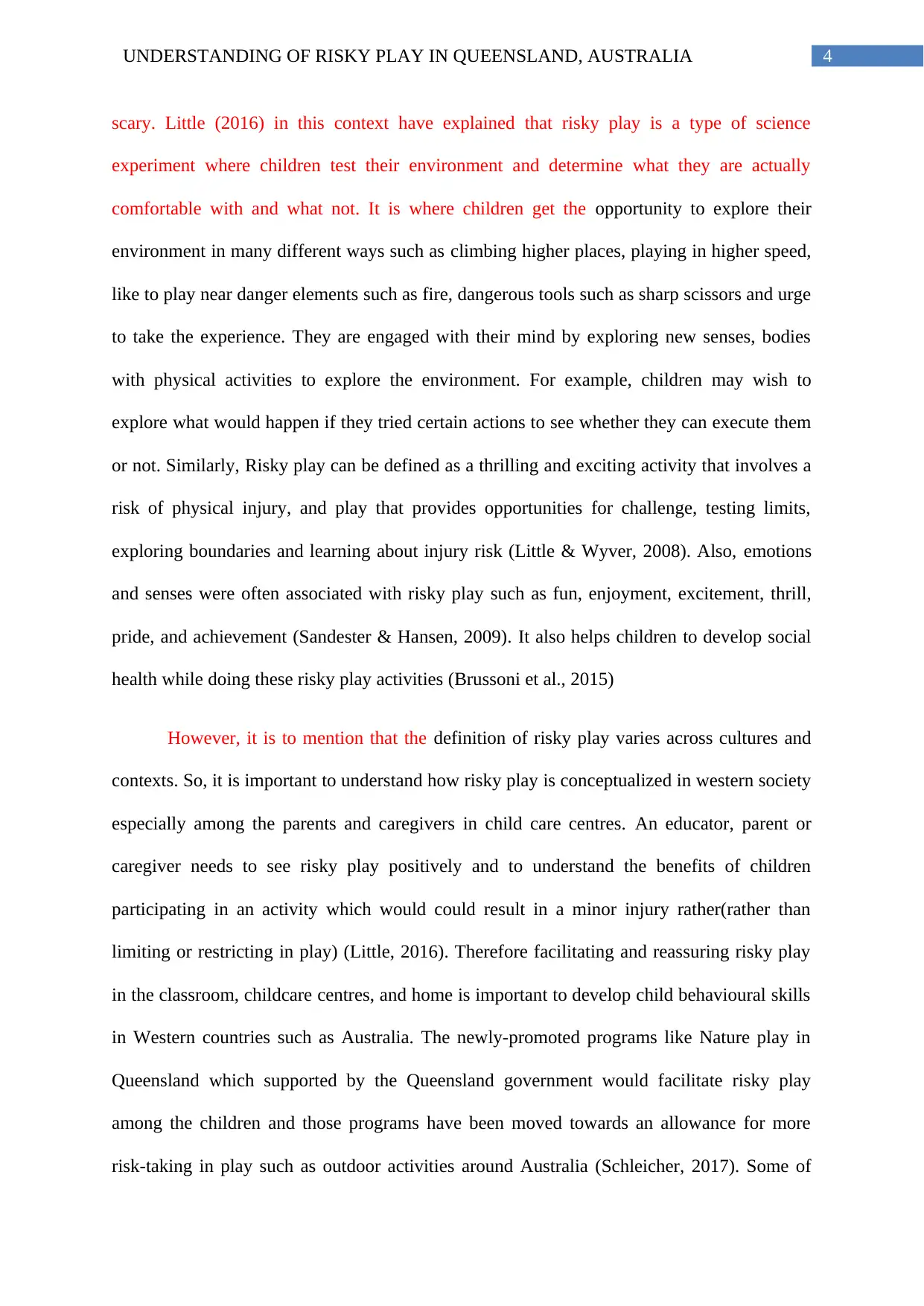
4UNDERSTANDING OF RISKY PLAY IN QUEENSLAND, AUSTRALIA
scary. Little (2016) in this context have explained that risky play is a type of science
experiment where children test their environment and determine what they are actually
comfortable with and what not. It is where children get the opportunity to explore their
environment in many different ways such as climbing higher places, playing in higher speed,
like to play near danger elements such as fire, dangerous tools such as sharp scissors and urge
to take the experience. They are engaged with their mind by exploring new senses, bodies
with physical activities to explore the environment. For example, children may wish to
explore what would happen if they tried certain actions to see whether they can execute them
or not. Similarly, Risky play can be defined as a thrilling and exciting activity that involves a
risk of physical injury, and play that provides opportunities for challenge, testing limits,
exploring boundaries and learning about injury risk (Little & Wyver, 2008). Also, emotions
and senses were often associated with risky play such as fun, enjoyment, excitement, thrill,
pride, and achievement (Sandester & Hansen, 2009). It also helps children to develop social
health while doing these risky play activities (Brussoni et al., 2015)
However, it is to mention that the definition of risky play varies across cultures and
contexts. So, it is important to understand how risky play is conceptualized in western society
especially among the parents and caregivers in child care centres. An educator, parent or
caregiver needs to see risky play positively and to understand the benefits of children
participating in an activity which would could result in a minor injury rather(rather than
limiting or restricting in play) (Little, 2016). Therefore facilitating and reassuring risky play
in the classroom, childcare centres, and home is important to develop child behavioural skills
in Western countries such as Australia. The newly-promoted programs like Nature play in
Queensland which supported by the Queensland government would facilitate risky play
among the children and those programs have been moved towards an allowance for more
risk-taking in play such as outdoor activities around Australia (Schleicher, 2017). Some of
scary. Little (2016) in this context have explained that risky play is a type of science
experiment where children test their environment and determine what they are actually
comfortable with and what not. It is where children get the opportunity to explore their
environment in many different ways such as climbing higher places, playing in higher speed,
like to play near danger elements such as fire, dangerous tools such as sharp scissors and urge
to take the experience. They are engaged with their mind by exploring new senses, bodies
with physical activities to explore the environment. For example, children may wish to
explore what would happen if they tried certain actions to see whether they can execute them
or not. Similarly, Risky play can be defined as a thrilling and exciting activity that involves a
risk of physical injury, and play that provides opportunities for challenge, testing limits,
exploring boundaries and learning about injury risk (Little & Wyver, 2008). Also, emotions
and senses were often associated with risky play such as fun, enjoyment, excitement, thrill,
pride, and achievement (Sandester & Hansen, 2009). It also helps children to develop social
health while doing these risky play activities (Brussoni et al., 2015)
However, it is to mention that the definition of risky play varies across cultures and
contexts. So, it is important to understand how risky play is conceptualized in western society
especially among the parents and caregivers in child care centres. An educator, parent or
caregiver needs to see risky play positively and to understand the benefits of children
participating in an activity which would could result in a minor injury rather(rather than
limiting or restricting in play) (Little, 2016). Therefore facilitating and reassuring risky play
in the classroom, childcare centres, and home is important to develop child behavioural skills
in Western countries such as Australia. The newly-promoted programs like Nature play in
Queensland which supported by the Queensland government would facilitate risky play
among the children and those programs have been moved towards an allowance for more
risk-taking in play such as outdoor activities around Australia (Schleicher, 2017). Some of
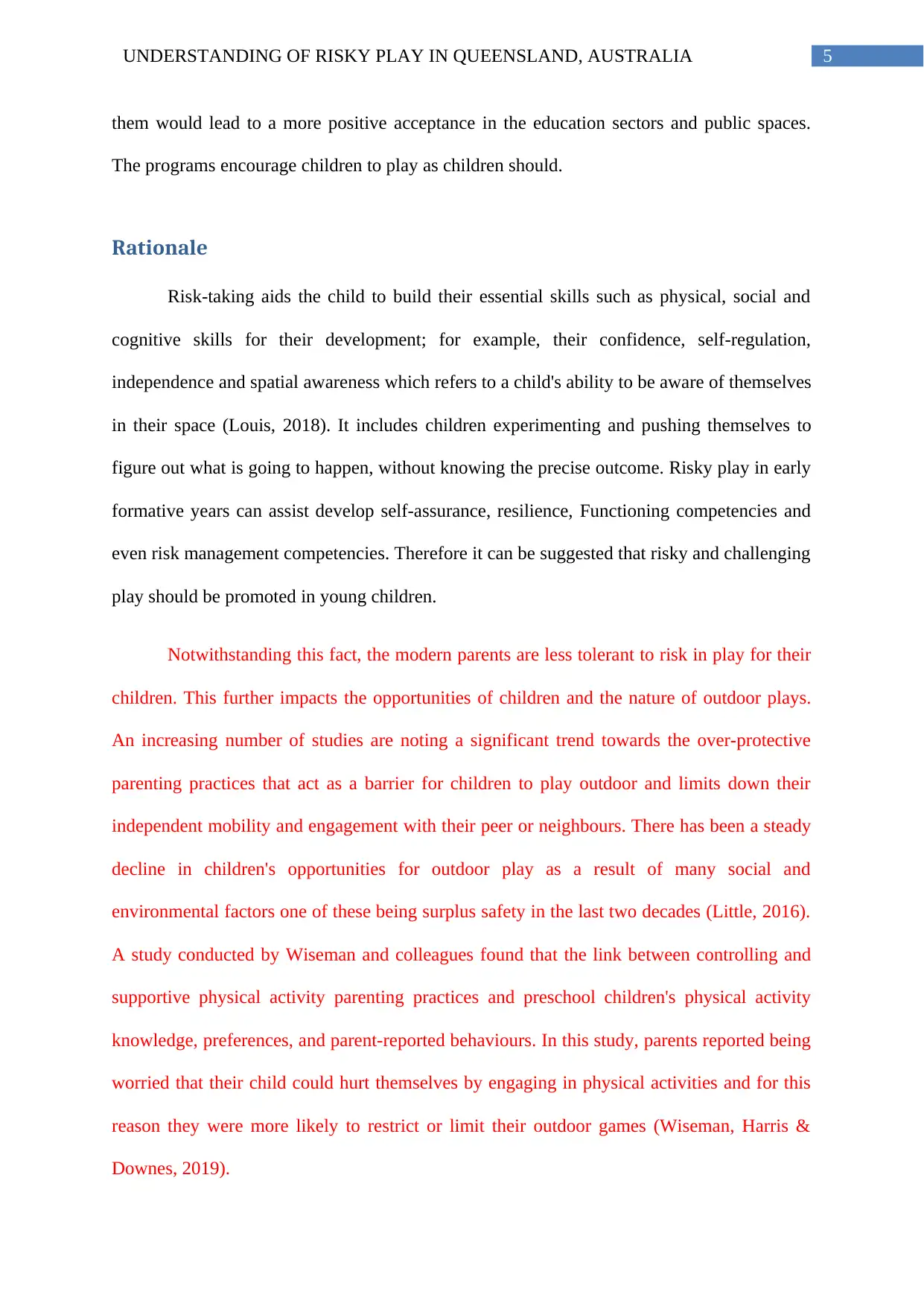
5UNDERSTANDING OF RISKY PLAY IN QUEENSLAND, AUSTRALIA
them would lead to a more positive acceptance in the education sectors and public spaces.
The programs encourage children to play as children should.
Rationale
Risk-taking aids the child to build their essential skills such as physical, social and
cognitive skills for their development; for example, their confidence, self-regulation,
independence and spatial awareness which refers to a child's ability to be aware of themselves
in their space (Louis, 2018). It includes children experimenting and pushing themselves to
figure out what is going to happen, without knowing the precise outcome. Risky play in early
formative years can assist develop self-assurance, resilience, Functioning competencies and
even risk management competencies. Therefore it can be suggested that risky and challenging
play should be promoted in young children.
Notwithstanding this fact, the modern parents are less tolerant to risk in play for their
children. This further impacts the opportunities of children and the nature of outdoor plays.
An increasing number of studies are noting a significant trend towards the over-protective
parenting practices that act as a barrier for children to play outdoor and limits down their
independent mobility and engagement with their peer or neighbours. There has been a steady
decline in children's opportunities for outdoor play as a result of many social and
environmental factors one of these being surplus safety in the last two decades (Little, 2016).
A study conducted by Wiseman and colleagues found that the link between controlling and
supportive physical activity parenting practices and preschool children's physical activity
knowledge, preferences, and parent-reported behaviours. In this study, parents reported being
worried that their child could hurt themselves by engaging in physical activities and for this
reason they were more likely to restrict or limit their outdoor games (Wiseman, Harris &
Downes, 2019).
them would lead to a more positive acceptance in the education sectors and public spaces.
The programs encourage children to play as children should.
Rationale
Risk-taking aids the child to build their essential skills such as physical, social and
cognitive skills for their development; for example, their confidence, self-regulation,
independence and spatial awareness which refers to a child's ability to be aware of themselves
in their space (Louis, 2018). It includes children experimenting and pushing themselves to
figure out what is going to happen, without knowing the precise outcome. Risky play in early
formative years can assist develop self-assurance, resilience, Functioning competencies and
even risk management competencies. Therefore it can be suggested that risky and challenging
play should be promoted in young children.
Notwithstanding this fact, the modern parents are less tolerant to risk in play for their
children. This further impacts the opportunities of children and the nature of outdoor plays.
An increasing number of studies are noting a significant trend towards the over-protective
parenting practices that act as a barrier for children to play outdoor and limits down their
independent mobility and engagement with their peer or neighbours. There has been a steady
decline in children's opportunities for outdoor play as a result of many social and
environmental factors one of these being surplus safety in the last two decades (Little, 2016).
A study conducted by Wiseman and colleagues found that the link between controlling and
supportive physical activity parenting practices and preschool children's physical activity
knowledge, preferences, and parent-reported behaviours. In this study, parents reported being
worried that their child could hurt themselves by engaging in physical activities and for this
reason they were more likely to restrict or limit their outdoor games (Wiseman, Harris &
Downes, 2019).
⊘ This is a preview!⊘
Do you want full access?
Subscribe today to unlock all pages.

Trusted by 1+ million students worldwide
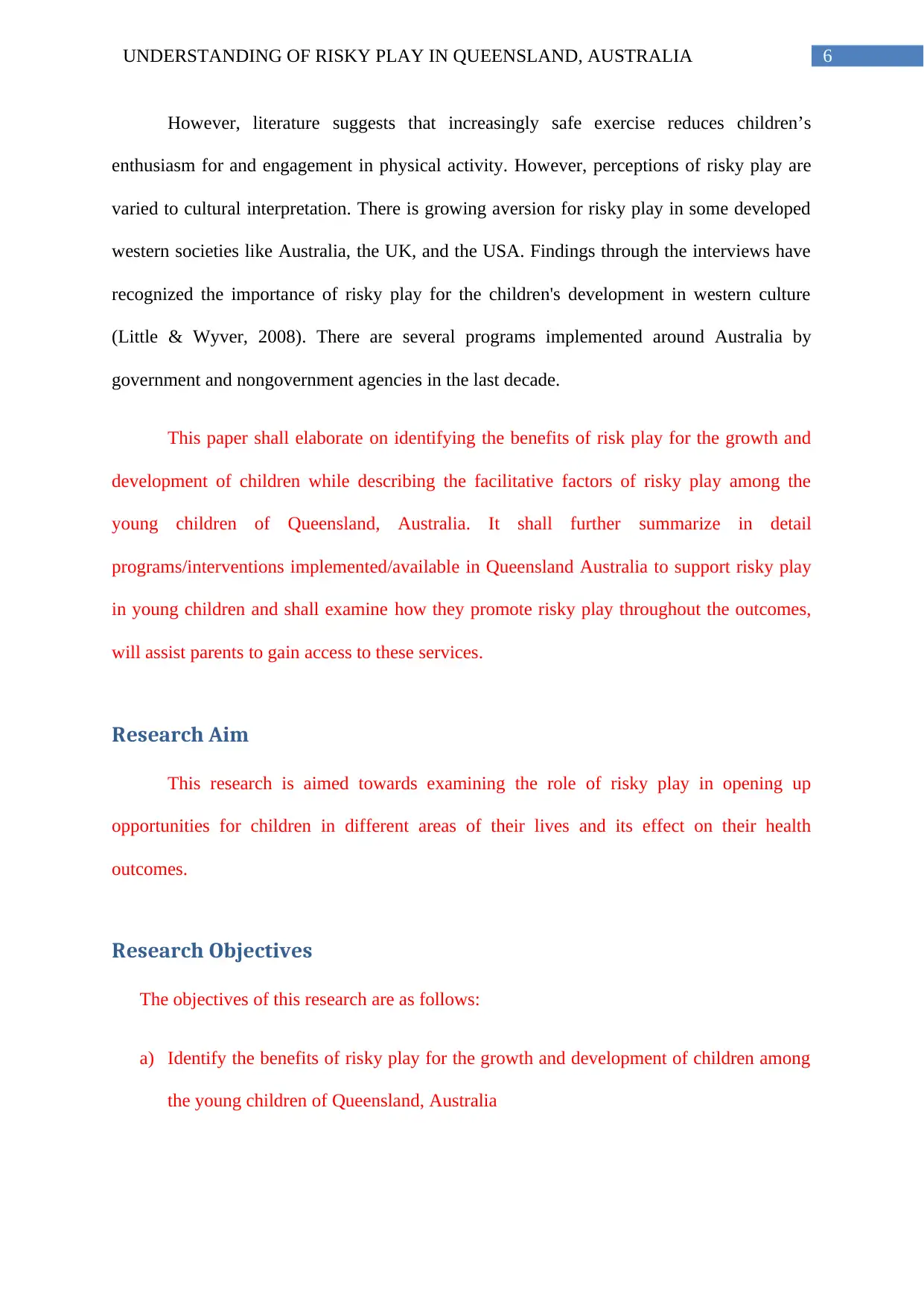
6UNDERSTANDING OF RISKY PLAY IN QUEENSLAND, AUSTRALIA
However, literature suggests that increasingly safe exercise reduces children’s
enthusiasm for and engagement in physical activity. However, perceptions of risky play are
varied to cultural interpretation. There is growing aversion for risky play in some developed
western societies like Australia, the UK, and the USA. Findings through the interviews have
recognized the importance of risky play for the children's development in western culture
(Little & Wyver, 2008). There are several programs implemented around Australia by
government and nongovernment agencies in the last decade.
This paper shall elaborate on identifying the benefits of risk play for the growth and
development of children while describing the facilitative factors of risky play among the
young children of Queensland, Australia. It shall further summarize in detail
programs/interventions implemented/available in Queensland Australia to support risky play
in young children and shall examine how they promote risky play throughout the outcomes,
will assist parents to gain access to these services.
Research Aim
This research is aimed towards examining the role of risky play in opening up
opportunities for children in different areas of their lives and its effect on their health
outcomes.
Research Objectives
The objectives of this research are as follows:
a) Identify the benefits of risky play for the growth and development of children among
the young children of Queensland, Australia
However, literature suggests that increasingly safe exercise reduces children’s
enthusiasm for and engagement in physical activity. However, perceptions of risky play are
varied to cultural interpretation. There is growing aversion for risky play in some developed
western societies like Australia, the UK, and the USA. Findings through the interviews have
recognized the importance of risky play for the children's development in western culture
(Little & Wyver, 2008). There are several programs implemented around Australia by
government and nongovernment agencies in the last decade.
This paper shall elaborate on identifying the benefits of risk play for the growth and
development of children while describing the facilitative factors of risky play among the
young children of Queensland, Australia. It shall further summarize in detail
programs/interventions implemented/available in Queensland Australia to support risky play
in young children and shall examine how they promote risky play throughout the outcomes,
will assist parents to gain access to these services.
Research Aim
This research is aimed towards examining the role of risky play in opening up
opportunities for children in different areas of their lives and its effect on their health
outcomes.
Research Objectives
The objectives of this research are as follows:
a) Identify the benefits of risky play for the growth and development of children among
the young children of Queensland, Australia
Paraphrase This Document
Need a fresh take? Get an instant paraphrase of this document with our AI Paraphraser
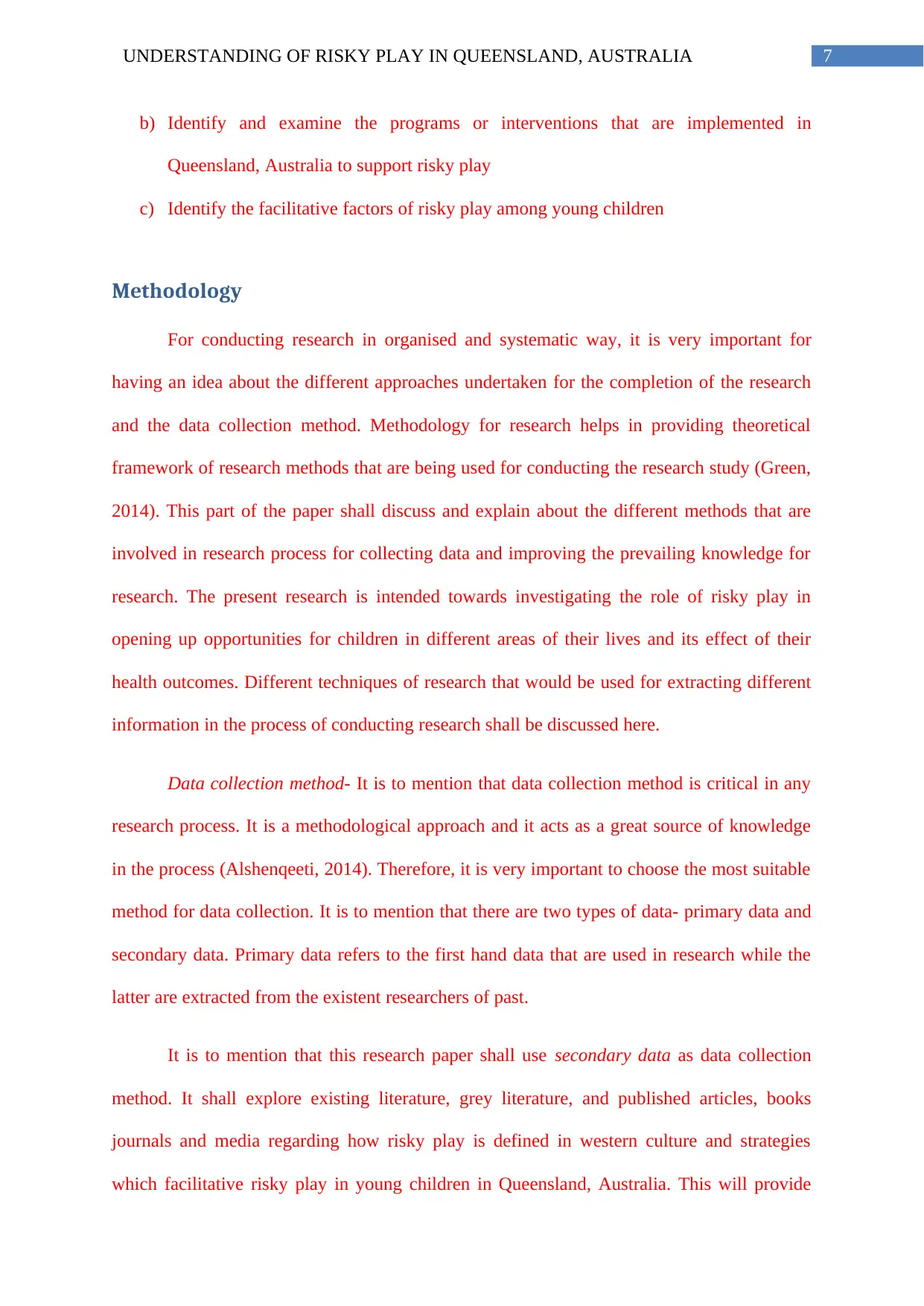
7UNDERSTANDING OF RISKY PLAY IN QUEENSLAND, AUSTRALIA
b) Identify and examine the programs or interventions that are implemented in
Queensland, Australia to support risky play
c) Identify the facilitative factors of risky play among young children
Methodology
For conducting research in organised and systematic way, it is very important for
having an idea about the different approaches undertaken for the completion of the research
and the data collection method. Methodology for research helps in providing theoretical
framework of research methods that are being used for conducting the research study (Green,
2014). This part of the paper shall discuss and explain about the different methods that are
involved in research process for collecting data and improving the prevailing knowledge for
research. The present research is intended towards investigating the role of risky play in
opening up opportunities for children in different areas of their lives and its effect of their
health outcomes. Different techniques of research that would be used for extracting different
information in the process of conducting research shall be discussed here.
Data collection method- It is to mention that data collection method is critical in any
research process. It is a methodological approach and it acts as a great source of knowledge
in the process (Alshenqeeti, 2014). Therefore, it is very important to choose the most suitable
method for data collection. It is to mention that there are two types of data- primary data and
secondary data. Primary data refers to the first hand data that are used in research while the
latter are extracted from the existent researchers of past.
It is to mention that this research paper shall use secondary data as data collection
method. It shall explore existing literature, grey literature, and published articles, books
journals and media regarding how risky play is defined in western culture and strategies
which facilitative risky play in young children in Queensland, Australia. This will provide
b) Identify and examine the programs or interventions that are implemented in
Queensland, Australia to support risky play
c) Identify the facilitative factors of risky play among young children
Methodology
For conducting research in organised and systematic way, it is very important for
having an idea about the different approaches undertaken for the completion of the research
and the data collection method. Methodology for research helps in providing theoretical
framework of research methods that are being used for conducting the research study (Green,
2014). This part of the paper shall discuss and explain about the different methods that are
involved in research process for collecting data and improving the prevailing knowledge for
research. The present research is intended towards investigating the role of risky play in
opening up opportunities for children in different areas of their lives and its effect of their
health outcomes. Different techniques of research that would be used for extracting different
information in the process of conducting research shall be discussed here.
Data collection method- It is to mention that data collection method is critical in any
research process. It is a methodological approach and it acts as a great source of knowledge
in the process (Alshenqeeti, 2014). Therefore, it is very important to choose the most suitable
method for data collection. It is to mention that there are two types of data- primary data and
secondary data. Primary data refers to the first hand data that are used in research while the
latter are extracted from the existent researchers of past.
It is to mention that this research paper shall use secondary data as data collection
method. It shall explore existing literature, grey literature, and published articles, books
journals and media regarding how risky play is defined in western culture and strategies
which facilitative risky play in young children in Queensland, Australia. This will provide
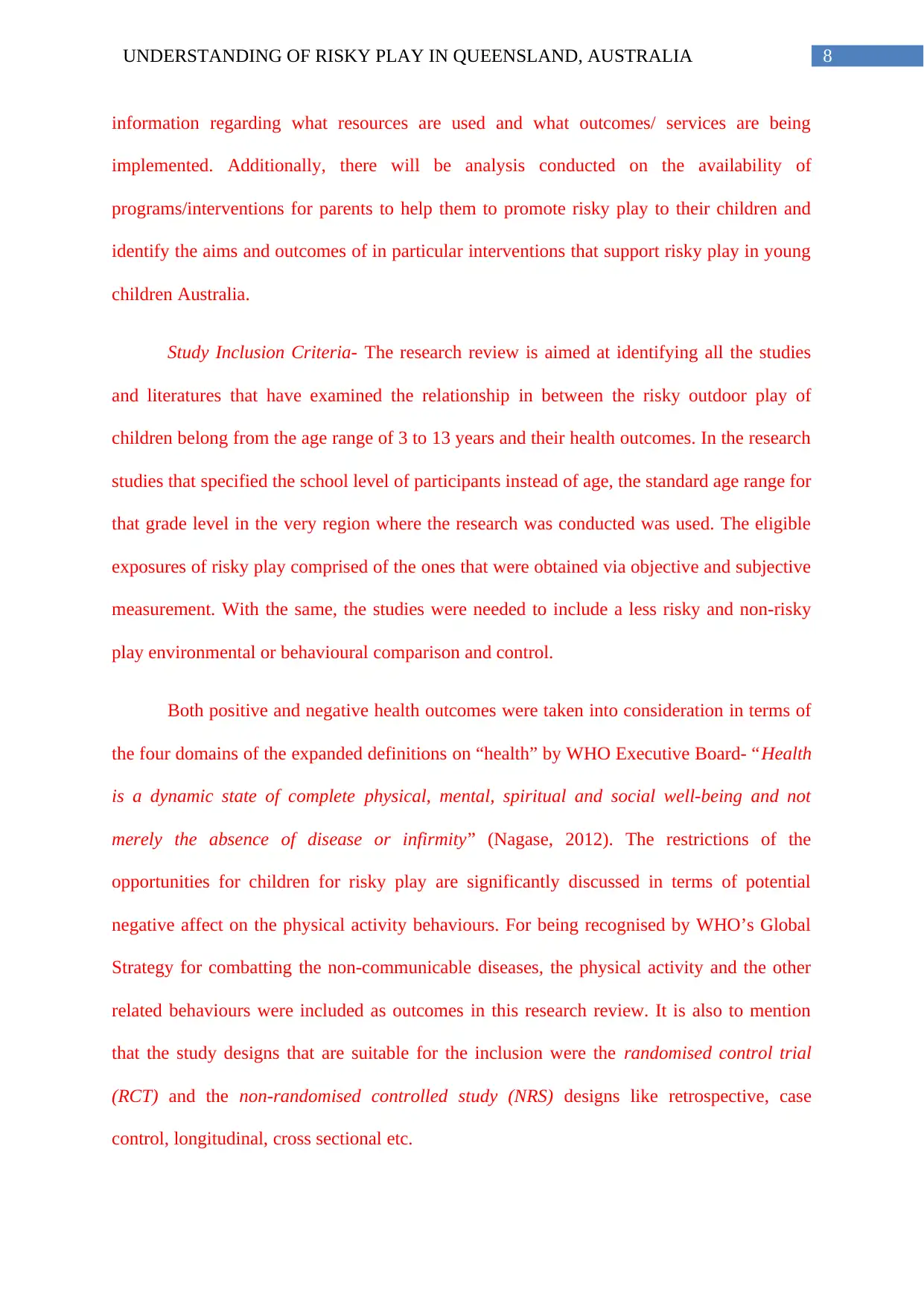
8UNDERSTANDING OF RISKY PLAY IN QUEENSLAND, AUSTRALIA
information regarding what resources are used and what outcomes/ services are being
implemented. Additionally, there will be analysis conducted on the availability of
programs/interventions for parents to help them to promote risky play to their children and
identify the aims and outcomes of in particular interventions that support risky play in young
children Australia.
Study Inclusion Criteria- The research review is aimed at identifying all the studies
and literatures that have examined the relationship in between the risky outdoor play of
children belong from the age range of 3 to 13 years and their health outcomes. In the research
studies that specified the school level of participants instead of age, the standard age range for
that grade level in the very region where the research was conducted was used. The eligible
exposures of risky play comprised of the ones that were obtained via objective and subjective
measurement. With the same, the studies were needed to include a less risky and non-risky
play environmental or behavioural comparison and control.
Both positive and negative health outcomes were taken into consideration in terms of
the four domains of the expanded definitions on “health” by WHO Executive Board- “Health
is a dynamic state of complete physical, mental, spiritual and social well-being and not
merely the absence of disease or infirmity” (Nagase, 2012). The restrictions of the
opportunities for children for risky play are significantly discussed in terms of potential
negative affect on the physical activity behaviours. For being recognised by WHO’s Global
Strategy for combatting the non-communicable diseases, the physical activity and the other
related behaviours were included as outcomes in this research review. It is also to mention
that the study designs that are suitable for the inclusion were the randomised control trial
(RCT) and the non-randomised controlled study (NRS) designs like retrospective, case
control, longitudinal, cross sectional etc.
information regarding what resources are used and what outcomes/ services are being
implemented. Additionally, there will be analysis conducted on the availability of
programs/interventions for parents to help them to promote risky play to their children and
identify the aims and outcomes of in particular interventions that support risky play in young
children Australia.
Study Inclusion Criteria- The research review is aimed at identifying all the studies
and literatures that have examined the relationship in between the risky outdoor play of
children belong from the age range of 3 to 13 years and their health outcomes. In the research
studies that specified the school level of participants instead of age, the standard age range for
that grade level in the very region where the research was conducted was used. The eligible
exposures of risky play comprised of the ones that were obtained via objective and subjective
measurement. With the same, the studies were needed to include a less risky and non-risky
play environmental or behavioural comparison and control.
Both positive and negative health outcomes were taken into consideration in terms of
the four domains of the expanded definitions on “health” by WHO Executive Board- “Health
is a dynamic state of complete physical, mental, spiritual and social well-being and not
merely the absence of disease or infirmity” (Nagase, 2012). The restrictions of the
opportunities for children for risky play are significantly discussed in terms of potential
negative affect on the physical activity behaviours. For being recognised by WHO’s Global
Strategy for combatting the non-communicable diseases, the physical activity and the other
related behaviours were included as outcomes in this research review. It is also to mention
that the study designs that are suitable for the inclusion were the randomised control trial
(RCT) and the non-randomised controlled study (NRS) designs like retrospective, case
control, longitudinal, cross sectional etc.
⊘ This is a preview!⊘
Do you want full access?
Subscribe today to unlock all pages.

Trusted by 1+ million students worldwide
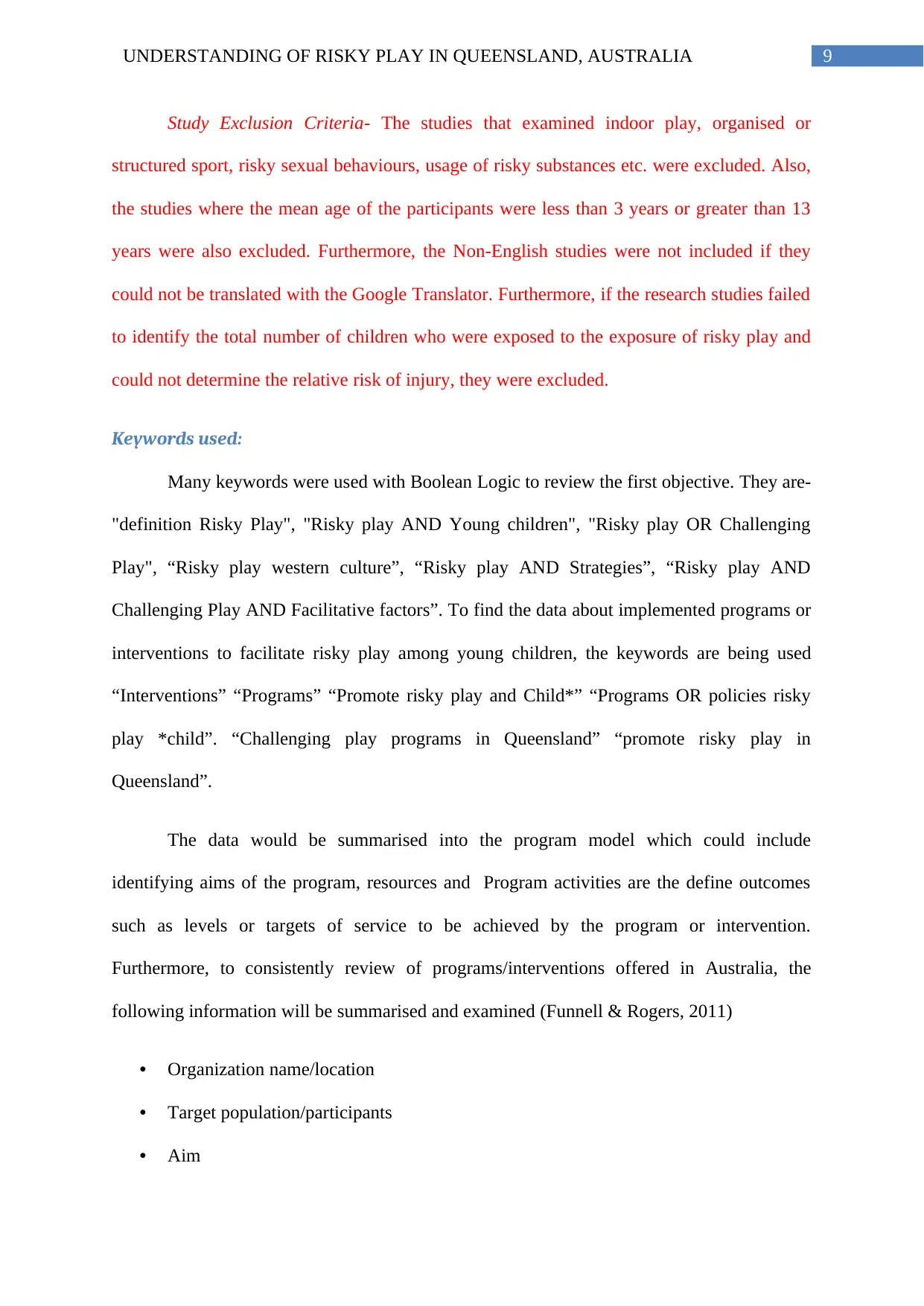
9UNDERSTANDING OF RISKY PLAY IN QUEENSLAND, AUSTRALIA
Study Exclusion Criteria- The studies that examined indoor play, organised or
structured sport, risky sexual behaviours, usage of risky substances etc. were excluded. Also,
the studies where the mean age of the participants were less than 3 years or greater than 13
years were also excluded. Furthermore, the Non-English studies were not included if they
could not be translated with the Google Translator. Furthermore, if the research studies failed
to identify the total number of children who were exposed to the exposure of risky play and
could not determine the relative risk of injury, they were excluded.
Keywords used:
Many keywords were used with Boolean Logic to review the first objective. They are-
"definition Risky Play", "Risky play AND Young children", "Risky play OR Challenging
Play", “Risky play western culture”, “Risky play AND Strategies”, “Risky play AND
Challenging Play AND Facilitative factors”. To find the data about implemented programs or
interventions to facilitate risky play among young children, the keywords are being used
“Interventions” “Programs” “Promote risky play and Child*” “Programs OR policies risky
play *child”. “Challenging play programs in Queensland” “promote risky play in
Queensland”.
The data would be summarised into the program model which could include
identifying aims of the program, resources and Program activities are the define outcomes
such as levels or targets of service to be achieved by the program or intervention.
Furthermore, to consistently review of programs/interventions offered in Australia, the
following information will be summarised and examined (Funnell & Rogers, 2011)
• Organization name/location
• Target population/participants
• Aim
Study Exclusion Criteria- The studies that examined indoor play, organised or
structured sport, risky sexual behaviours, usage of risky substances etc. were excluded. Also,
the studies where the mean age of the participants were less than 3 years or greater than 13
years were also excluded. Furthermore, the Non-English studies were not included if they
could not be translated with the Google Translator. Furthermore, if the research studies failed
to identify the total number of children who were exposed to the exposure of risky play and
could not determine the relative risk of injury, they were excluded.
Keywords used:
Many keywords were used with Boolean Logic to review the first objective. They are-
"definition Risky Play", "Risky play AND Young children", "Risky play OR Challenging
Play", “Risky play western culture”, “Risky play AND Strategies”, “Risky play AND
Challenging Play AND Facilitative factors”. To find the data about implemented programs or
interventions to facilitate risky play among young children, the keywords are being used
“Interventions” “Programs” “Promote risky play and Child*” “Programs OR policies risky
play *child”. “Challenging play programs in Queensland” “promote risky play in
Queensland”.
The data would be summarised into the program model which could include
identifying aims of the program, resources and Program activities are the define outcomes
such as levels or targets of service to be achieved by the program or intervention.
Furthermore, to consistently review of programs/interventions offered in Australia, the
following information will be summarised and examined (Funnell & Rogers, 2011)
• Organization name/location
• Target population/participants
• Aim
Paraphrase This Document
Need a fresh take? Get an instant paraphrase of this document with our AI Paraphraser
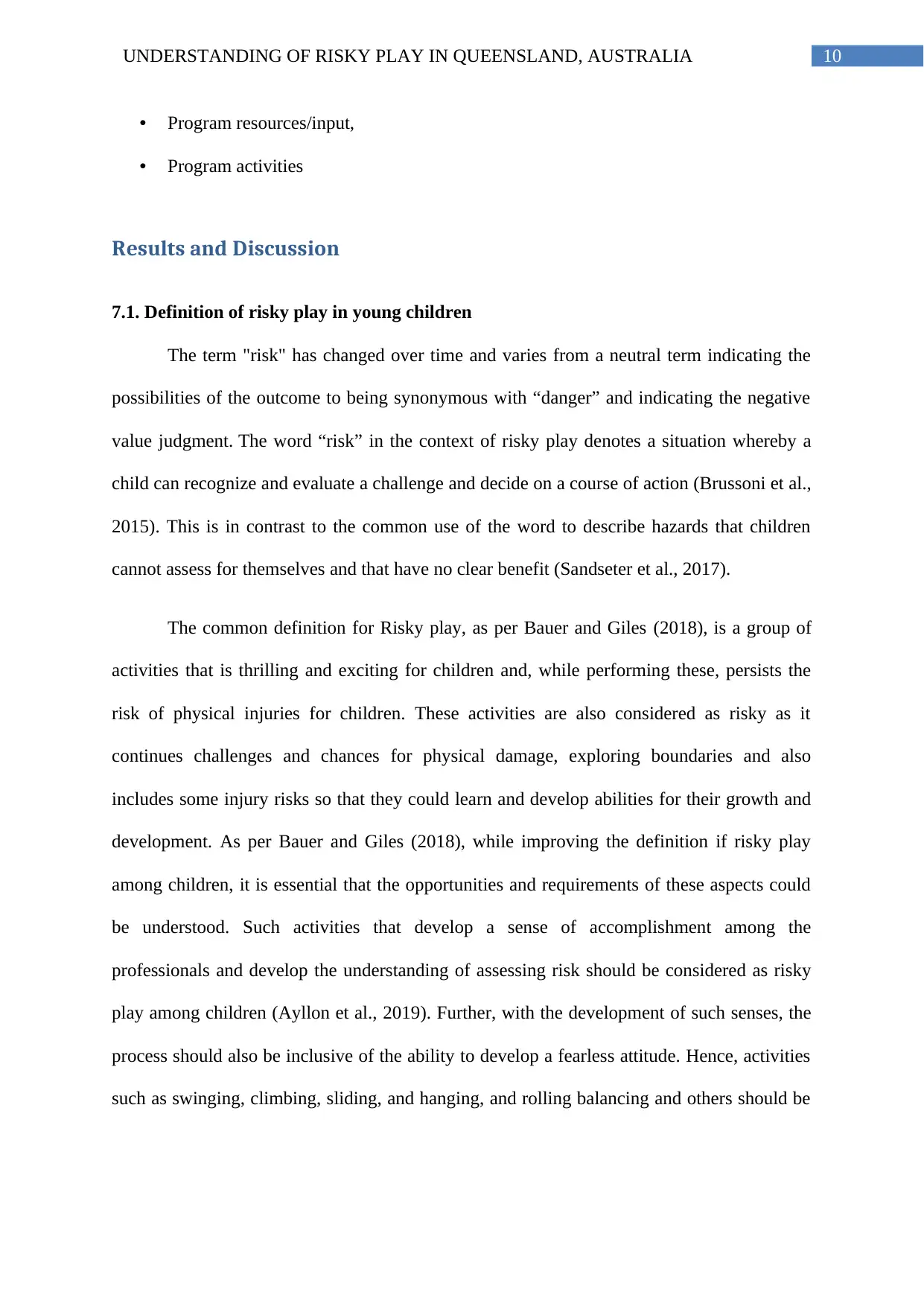
10UNDERSTANDING OF RISKY PLAY IN QUEENSLAND, AUSTRALIA
• Program resources/input,
• Program activities
Results and Discussion
7.1. Definition of risky play in young children
The term "risk" has changed over time and varies from a neutral term indicating the
possibilities of the outcome to being synonymous with “danger” and indicating the negative
value judgment. The word “risk” in the context of risky play denotes a situation whereby a
child can recognize and evaluate a challenge and decide on a course of action (Brussoni et al.,
2015). This is in contrast to the common use of the word to describe hazards that children
cannot assess for themselves and that have no clear benefit (Sandseter et al., 2017).
The common definition for Risky play, as per Bauer and Giles (2018), is a group of
activities that is thrilling and exciting for children and, while performing these, persists the
risk of physical injuries for children. These activities are also considered as risky as it
continues challenges and chances for physical damage, exploring boundaries and also
includes some injury risks so that they could learn and develop abilities for their growth and
development. As per Bauer and Giles (2018), while improving the definition if risky play
among children, it is essential that the opportunities and requirements of these aspects could
be understood. Such activities that develop a sense of accomplishment among the
professionals and develop the understanding of assessing risk should be considered as risky
play among children (Ayllon et al., 2019). Further, with the development of such senses, the
process should also be inclusive of the ability to develop a fearless attitude. Hence, activities
such as swinging, climbing, sliding, and hanging, and rolling balancing and others should be
• Program resources/input,
• Program activities
Results and Discussion
7.1. Definition of risky play in young children
The term "risk" has changed over time and varies from a neutral term indicating the
possibilities of the outcome to being synonymous with “danger” and indicating the negative
value judgment. The word “risk” in the context of risky play denotes a situation whereby a
child can recognize and evaluate a challenge and decide on a course of action (Brussoni et al.,
2015). This is in contrast to the common use of the word to describe hazards that children
cannot assess for themselves and that have no clear benefit (Sandseter et al., 2017).
The common definition for Risky play, as per Bauer and Giles (2018), is a group of
activities that is thrilling and exciting for children and, while performing these, persists the
risk of physical injuries for children. These activities are also considered as risky as it
continues challenges and chances for physical damage, exploring boundaries and also
includes some injury risks so that they could learn and develop abilities for their growth and
development. As per Bauer and Giles (2018), while improving the definition if risky play
among children, it is essential that the opportunities and requirements of these aspects could
be understood. Such activities that develop a sense of accomplishment among the
professionals and develop the understanding of assessing risk should be considered as risky
play among children (Ayllon et al., 2019). Further, with the development of such senses, the
process should also be inclusive of the ability to develop a fearless attitude. Hence, activities
such as swinging, climbing, sliding, and hanging, and rolling balancing and others should be
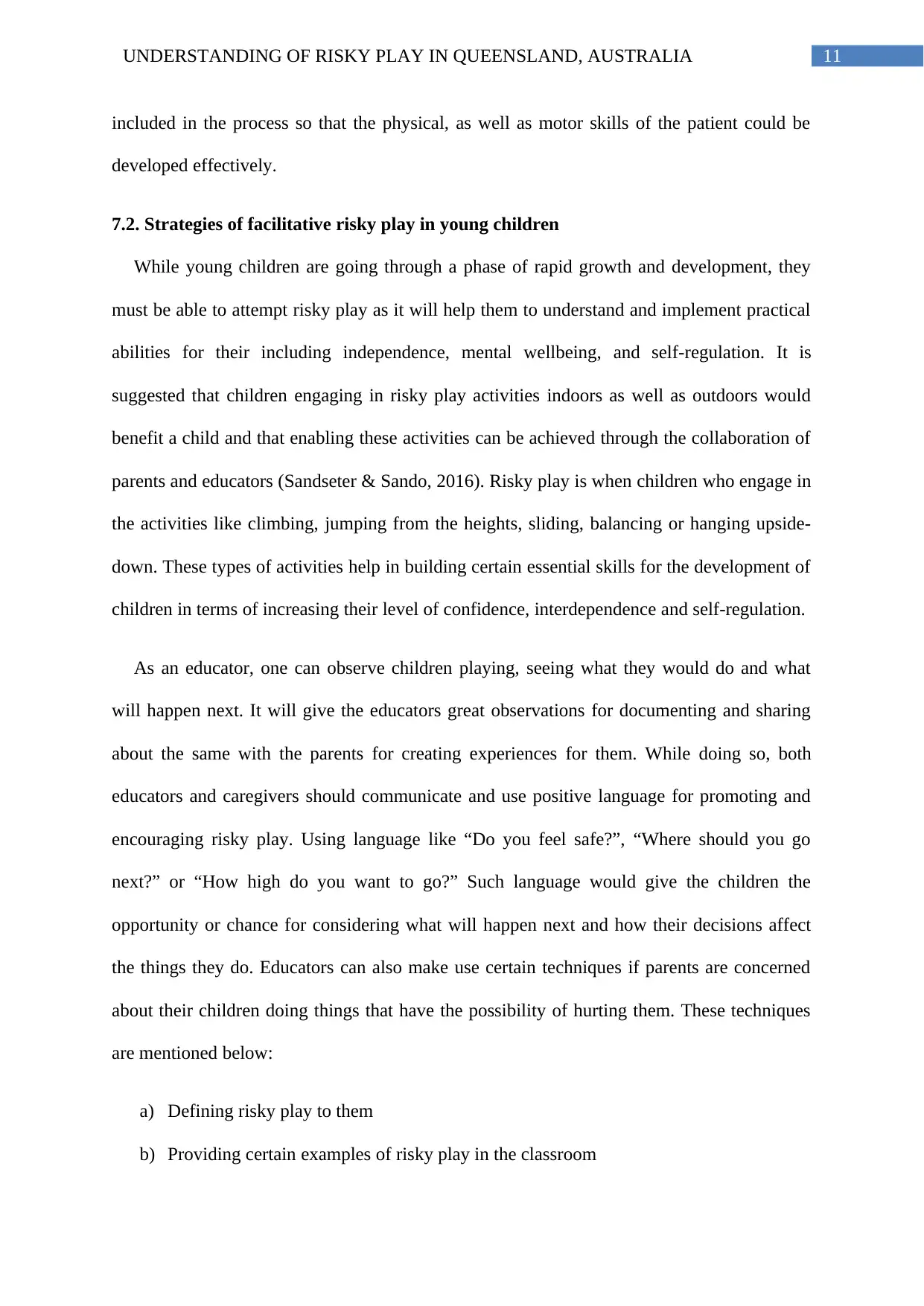
11UNDERSTANDING OF RISKY PLAY IN QUEENSLAND, AUSTRALIA
included in the process so that the physical, as well as motor skills of the patient could be
developed effectively.
7.2. Strategies of facilitative risky play in young children
While young children are going through a phase of rapid growth and development, they
must be able to attempt risky play as it will help them to understand and implement practical
abilities for their including independence, mental wellbeing, and self-regulation. It is
suggested that children engaging in risky play activities indoors as well as outdoors would
benefit a child and that enabling these activities can be achieved through the collaboration of
parents and educators (Sandseter & Sando, 2016). Risky play is when children who engage in
the activities like climbing, jumping from the heights, sliding, balancing or hanging upside-
down. These types of activities help in building certain essential skills for the development of
children in terms of increasing their level of confidence, interdependence and self-regulation.
As an educator, one can observe children playing, seeing what they would do and what
will happen next. It will give the educators great observations for documenting and sharing
about the same with the parents for creating experiences for them. While doing so, both
educators and caregivers should communicate and use positive language for promoting and
encouraging risky play. Using language like “Do you feel safe?”, “Where should you go
next?” or “How high do you want to go?” Such language would give the children the
opportunity or chance for considering what will happen next and how their decisions affect
the things they do. Educators can also make use certain techniques if parents are concerned
about their children doing things that have the possibility of hurting them. These techniques
are mentioned below:
a) Defining risky play to them
b) Providing certain examples of risky play in the classroom
included in the process so that the physical, as well as motor skills of the patient could be
developed effectively.
7.2. Strategies of facilitative risky play in young children
While young children are going through a phase of rapid growth and development, they
must be able to attempt risky play as it will help them to understand and implement practical
abilities for their including independence, mental wellbeing, and self-regulation. It is
suggested that children engaging in risky play activities indoors as well as outdoors would
benefit a child and that enabling these activities can be achieved through the collaboration of
parents and educators (Sandseter & Sando, 2016). Risky play is when children who engage in
the activities like climbing, jumping from the heights, sliding, balancing or hanging upside-
down. These types of activities help in building certain essential skills for the development of
children in terms of increasing their level of confidence, interdependence and self-regulation.
As an educator, one can observe children playing, seeing what they would do and what
will happen next. It will give the educators great observations for documenting and sharing
about the same with the parents for creating experiences for them. While doing so, both
educators and caregivers should communicate and use positive language for promoting and
encouraging risky play. Using language like “Do you feel safe?”, “Where should you go
next?” or “How high do you want to go?” Such language would give the children the
opportunity or chance for considering what will happen next and how their decisions affect
the things they do. Educators can also make use certain techniques if parents are concerned
about their children doing things that have the possibility of hurting them. These techniques
are mentioned below:
a) Defining risky play to them
b) Providing certain examples of risky play in the classroom
⊘ This is a preview!⊘
Do you want full access?
Subscribe today to unlock all pages.

Trusted by 1+ million students worldwide
1 out of 39
Related Documents
Your All-in-One AI-Powered Toolkit for Academic Success.
+13062052269
info@desklib.com
Available 24*7 on WhatsApp / Email
![[object Object]](/_next/static/media/star-bottom.7253800d.svg)
Unlock your academic potential
Copyright © 2020–2025 A2Z Services. All Rights Reserved. Developed and managed by ZUCOL.





